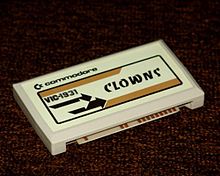Plug-in module

The term plug-in module (also called caddy or cartridge ) denotes either a component of a certain size that can be inserted into electronic devices and that is enclosed in a solid housing, or just the corresponding housing. This is usually made of plastic and is intended to protect the inside of the component from external influences such as contact, impact or moisture. The manageability increases.
Disk
Electronically
Electronic data carriers for game consoles in particular were often designed as plug-in modules ( game modules ) until the mid-1990s , for example in the SNES , Sega Mega Drive or Nintendo 64 . Since every game console manufacturer developed every console from scratch, the shape of the plug-in module usually underlined the electronic incompatibility mechanically. The proprietary standards made it very difficult to make copies. It was only when the memory on the internal circuit board became too expensive compared to optical media that the game console industry switched to using CDs (e.g. Sega Saturn , PlayStation ) and subsequent formats. Nowadays, in the game console sector, plug-in modules are almost exclusively found in portable devices, for example in Nintendo 3DS .
Connections for different modules of the SNES . The upper one has two additional narrow connections for an additional chip.
Multifunctional cartridge The Final Cartridge 3 for the C64
Sega Mega-Drive module with additional joypad sockets
Another area of application are additional memory for computer printers that z. B. contain other fonts or a PostScript interpreter.
Optically
In the early days of CD-ROM drives , it was common practice to first insert the compact disc (CD) into a protective housing ( caddy for rifle). Then the caddy and CD were pushed completely into the drive. These protective housings did not represent CD packaging . The basic idea was to store and use sensitive data media permanently protected from contact.
Optical media without a caddy / cartridge allow more cost-effective mechanics for the reading and writing devices as well as cheaper media. Because CDs turned out to be less sensitive than originally assumed, CD-ROM drives using Caddy disappeared from the market in the mid-1990s. Instead, you use drawer ( tray ) or plug-in mechanisms ( slot-in ).
With less common optical data carriers, cartridges are still used, such as the Phasewriter Dual (PD) published in 1995 , the MiniDisc or the Ultra Density Optical (UDO) standardized in 2004 . Plastic sleeves using UMDs are also used for the PlayStation Portable . Some DVD-RAM drives also require a cassette.
Blu-ray disc blanks LM-BRM50 from Panasonic. Dual Layer Discs BD-RE with 50 GB capacity embedded in a cartridge
Macintosh Quadra 660AV with caddy drive
Amiga A570 caddy drive
Microsoft Encarta '95 in the CD caddy
Magnetic
The term cartridge is used professionally for data carriers with easy-to-change magnetic tapes .
Magnetic disc media are more colloquially referred to as floppy disks and media with magnetic tape are more commonly referred to as cassettes.
printer
As in the English language printer cartridges and toner cartridges from printers as cartridge are referred to, this term is sometimes also in Germany.
Plug-in module as hardware Enhancements: Super Game Boy
Plug-in module as a memory extension for the Nintendo 64










